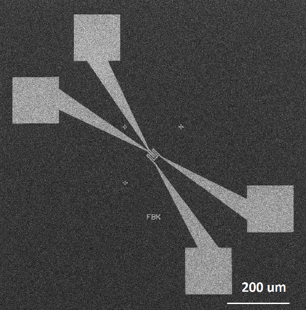Explore the offer
Lithography & Patterning / Lithographic techniques
Electron Beam Lithography

A typical electron beam lithography tool is a vector-scan direct-write tool with a Gaussian shaped beam. The electrons are accelerated (typically 5 keV to 30 keV), depending on the application) and the beam scanning is controlled by special beam-deflection systems. The beam is directed to a position in the main deflection field, where a pattern is written by stepping around the electron beam. For larger patterns, the pattern is divided into main field blocks, which are completely exposed one-by-one after mechanically moving the substrate to the right position. A laser interferometer can often measure the actual stage position, and this signal is fed back to the deflection system with a resolution even below a nanometer.
Electron-beam spot sizes can be focused to sub-10 nm in diameter. At the same time, a wide range of beam currents is available (depending on the tool, typically a few pA to 10 nA). This enables high-throughput as well as high-resolution exposures with a high degree of versatility. In addition, with high accelerating voltages, thick layers of e-beam resists can be exposed, with small forward electron scattering. With electron-beam lithography, aligning multiple levels of lithography with very high overlay precision is possible, with manual or automatic detection of alignment markers. Most systems can handle full wafers, mask blanks, and custom shaped samples and provide automatic laser focusing for height measurement. Users can implement or supply their designs in most standard formats, while specialized software is usually available for pattern preparation and proximity effect correction. Typical high resolution electron-beam resists are, among others, PMMA (positive tone) and HSQ (negative tone).

Available instruments
Select instruments to view their specifications and compare them (3 max)
Lab's Facility
Milano
POLIMI-POLIFAB
Trento